Kyphosis looks like - Study guides, Class notes & Summaries
Looking for the best study guides, study notes and summaries about Kyphosis looks like? On this page you'll find 98 study documents about Kyphosis looks like.
All 98 results
Sort by
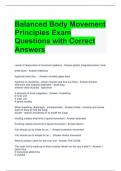
-
Balanced Body Movement Principles Exam Questions with Correct Answers
- Exam (elaborations) • 3 pages • 2024
-
- $12.99
- + learn more
Balanced Body Movement Principles Exam Questions with Correct Answers Levels of observation of movement patterns - Answer-global, integrated planar, local ankle bone - Answer-malleolus Kyphosis looks like... - Answer-rounded upper back Kyphosis is caused by...(which muscles and how are they) - Answer-thoracic extensors and scapular stabilizers - weak/long anterior chest muscles - tight/short 4 elements of trunk integration - Answer-1 breathing 2 inner unit 3 outer unit 4 ...
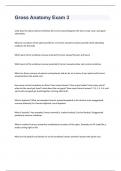
-
Gross Anatomy Exam 3 questions 2023 with correct answers
- Exam (elaborations) • 37 pages • 2023
-
- $12.99
- + learn more
what does the spinal column/vertebrae do? Supports the torso, head, neck, and upper extremities. What do curvatures of the spine provide for us? Curvatures provide shock-absorbing resilience for the body Which parts of the vertebrae concave anteriorly? Thoracic and Sacral Which parts of the vertebrae concave posteriorly? Lumbar and cervical vertebrae What can these concaves of anterior and posterior side do for us in terms of our spinal cord? protects the spinal ...
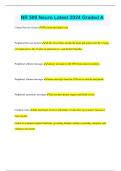
-
NR 509 Neuro Latest 2024 Graded A
- Exam (elaborations) • 5 pages • 2024
- Available in package deal
-
- $8.99
- + learn more
NR 509 Neuro Latest 2024 Graded A Central Nervous System The brain and spinal cord Peripheral Nervous System all the nerve fibers outside the brain and spinal cord: the 12 pairs of cranial nerves, the 31 pairs of spinal nerves , and all their branches Peripheral: afferent messages sensory messages to the CNS from sensory receptors Peripheral: efferent messages motor messages from the CNS out to muscles and glands Peripheral: autonomic messages govern the internal. organs and blood vessels C...

-
HESI Assessment All Answers Correct 2024
- Exam (elaborations) • 16 pages • 2024
-
Available in package deal
-
- $10.99
- + learn more
HESI Assessment All Answers Correct 2024 Which assessment technique should the nurse use to confirm the presence of papilledema in a client with a rapidly decreasing level of consciousness? A. Percussion B. Palpation C. Inspection D. Auscultation C. Inspection Nurse notes an enlarged, visible lymph node on the client's neck. What action should the nurse take next? A. Record this normal finding in the assessment record. B. Auscultate the lymph node for the presence of ...
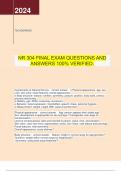
-
NR 304 FINAL EXAM QUESTIONS AND ANSWERS 100% VERIFIED.
- Exam (elaborations) • 12 pages • 2024
-
- $14.99
- + learn more
2024 TECHDGRADES NR 304 FINAL EXAM QUESTIONS AND ANSWERS 100% VERIFIED. Components of General Survey - correct answer. o Physical appearance- age, sex, LOC, skin color, facial features, overall appearance, o Body structure- stature, nutrition, symmetry, posture, position, body build, contour, physical deformities. o Mobility- gait, ROM, involuntary movement. o Behavior- facial expression, mood/affect, speech, dress, personal hygiene. o Meas...
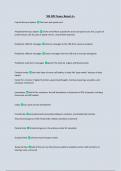
-
NR 509 Neuro Rated A+
- Exam (elaborations) • 3 pages • 2024
-
Available in package deal
-
- $11.99
- + learn more
NR 509 Neuro Rated A+ Central Nervous System Peripheral Nervous System The brain and spinal cord all the nerve fibers outside the brain and spinal cord: the 12 pairs of cranial nerves, the 31 pairs of spinal nerves , and all their branches Peripheral: afferent messages Peripheral: efferent messages Peripheral: autonomic messages Cerebral cortex sensory messages to the CNS from sensory receptors motor messages from the CNS out to muscles and glands govern the i...
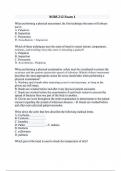
-
NURS 212 Exam 1
- Exam (elaborations) • 47 pages • 2024
-
Available in package deal
-
- $13.00
- + learn more
When performing a physical assessment, the first technique the nurse will always use is: A. Palpation. B. Inspection. C. Percussion. D. Auscultation. - Inspection Which of these techniques uses the sense of touch to assess texture, temperature, moisture, and swelling when the nurse is assessing a patient? A. Palpation B. Inspection C. Percussion D. Auscultation - Palpation When performing a physical examination, safety must be considered to protect the examiner and the patient again...
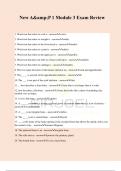
-
New A&P 1 Module 3 Exam Review
- Exam (elaborations) • 11 pages • 2024
-
- $12.49
- + learn more
New A&P 1 Module 3 Exam Review 1. Word root that refers to a rib is - answercost/o. 2. Word root that refers to straight is - answerorth/o. 3. Word root that refers to the lower back is - answerlumb/o. 4. Word root that refers to a joint is - answerarthr/o. 5. Word root that refers to the upper jaw is - answermaxill/o. 6. Word root that does not refer to a bone in the hip is - answercondyl/o. 7. Word root that refers to cartilage is - answerchondr/o. 8. The two major divisions of the...
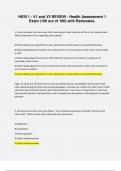
-
HESI 1 - V1 and V2 REVIEW - Health Assessment 1 Exam (100 out of 100) with Rationales.
- Exam (elaborations) • 48 pages • 2023
-
Available in package deal
-
- $12.99
- + learn more
the patient's nonverbal behaviors. B) Note-taking allows the patient to continue at his or her own pace as the nurse records what is said. C) Note-taking allows the nurse to shift attention away from the patient, resulting in an increased comfort level. D) Note-taking allows the nurse to break eye contact with the patient, which may increase his or her level of comfort. A) Note-taking may impede the nurse's observation of the patient's nonverbal behaviors. Page: 31 Some use of history forms a...
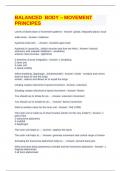
-
BALANCED BODY – MOVEMENT PRINCIPES QUESTIONS AND ANSWERS
- Exam (elaborations) • 3 pages • 2024
-
- $10.49
- + learn more
BALANCED BODY – MOVEMENT PRINCIPES Levels of observation of movement patterns - Answer- global, integrated planar, local ankle bone - Answer- malleolus Kyphosis looks like... - Answer- rounded upper back Kyphosis is caused by...(which muscles and how are they) - Answer- thoracic extensors and scapular stabilizers - weak/long anterior chest muscles - tight/short 4 elements of trunk integration - Answer- 1 breathing 2 inner unit 3 outer unit 4 spinal mobility When brea...

That summary you just bought made someone very happy. Also get paid weekly? Sell your study resources on Stuvia! Discover all about earning on Stuvia


